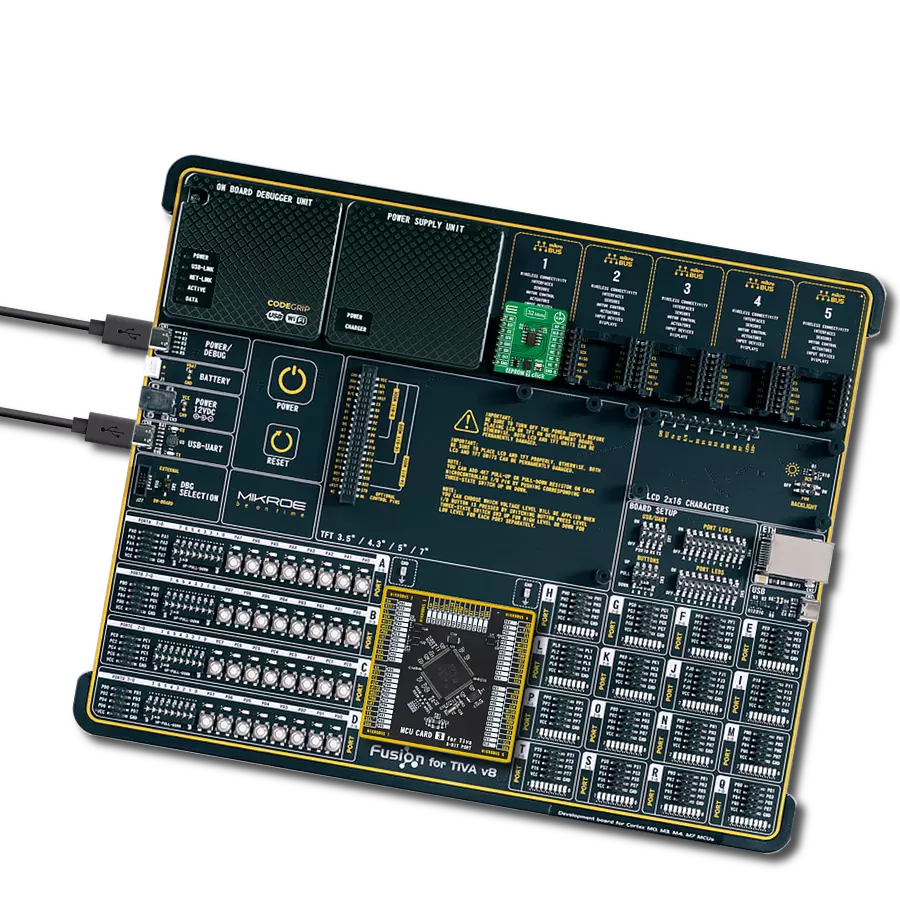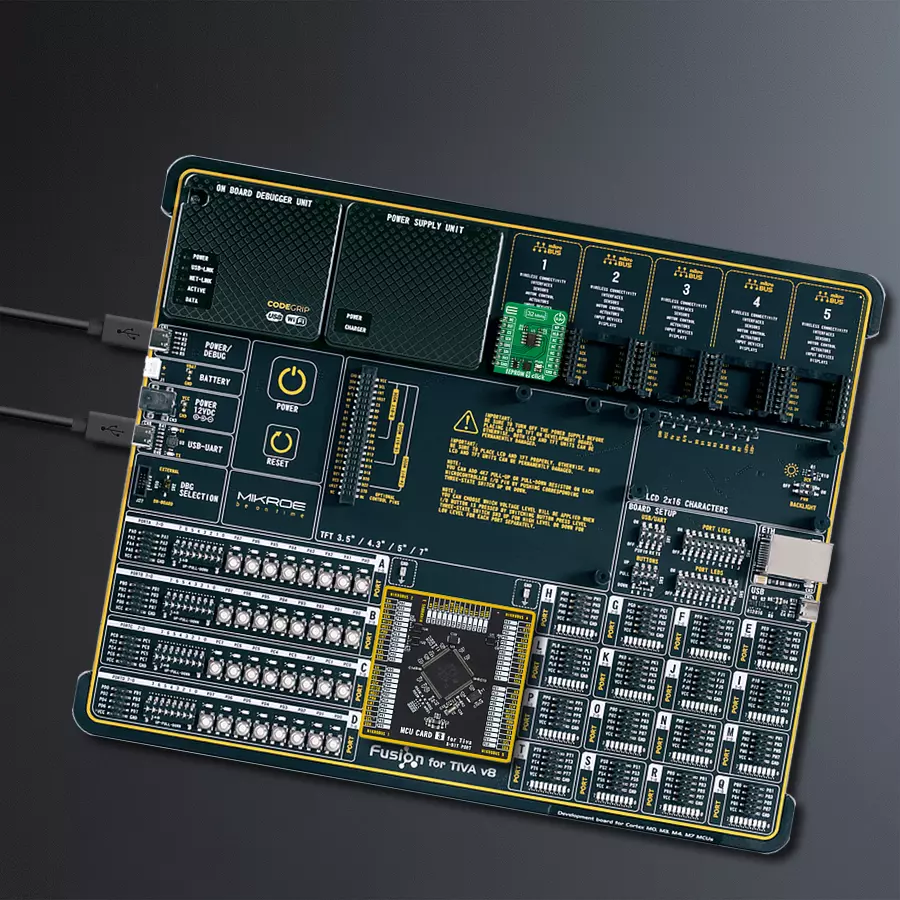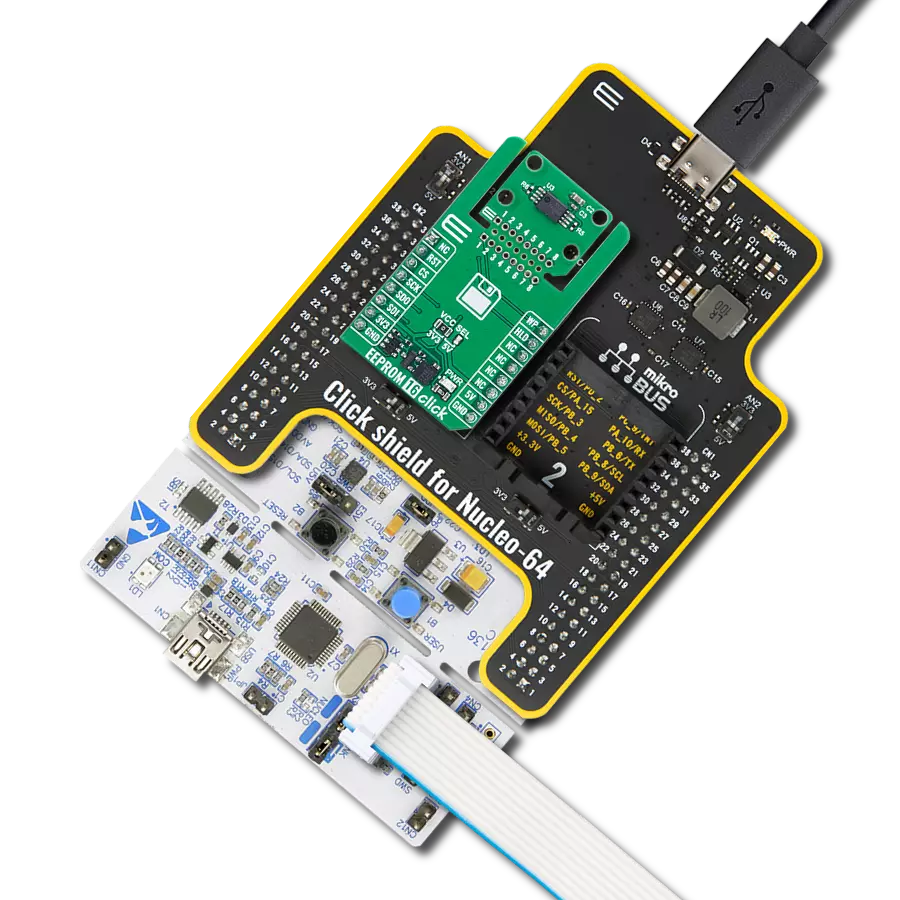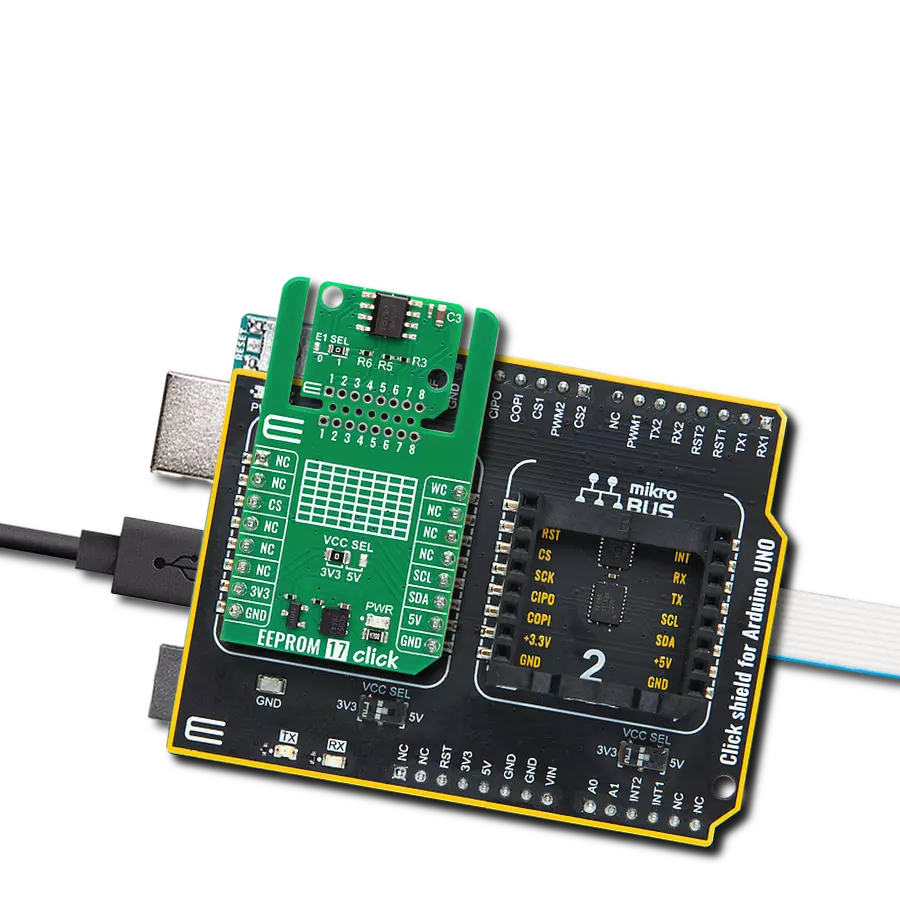Our EEPROM solution guarantees secure data storage, which is ideal for sensitive information such as encryption keys, boot sequences, and critical system parameters
A
A
Hardware Overview
How does it work?
EEPROM 9 Click is based on the M95P32-I, a 32Mbit SPI page EEPROM device from STMicroelectronics, divided into 8192 erasable pages of 512 bytes (organized either as 1024 erasable sectors of 4 Kbytes, 64 erasable blocks of 64 Kbytes or as an entirely erasable array). The M95P32-I is manufactured with ST's advanced proprietary NVM technology and offers byte flexibility, page alterability, high page cycling performance, and ultra-low power consumption. It is highly reliable, lasting 500k write cycles with 100 years of data retention (10 years after 500k cycles), which makes it suitable for various applications where dependable nonvolatile memory storage is essential. This Click board™ communicates with MCU using the SPI serial interface that supports the two most common modes, SPI Mode 0 and 3, with a maximum SPI frequency of 80MHz.
As mentioned, the M95P32-I offers byte and page write instructions of up to 512 bytes. Write instructions consist of self-timed auto-erase and program operations, resulting in flexible data byte management. It also accepts page/block/sector/chip erase commands to set the memory to an erased state. The memory can then be fast-programmed by pages of 512 bytes and further optimized using the "page program with buffer load" to hide the SPI communication latency. Additional status, configuration, and volatile registers set the desired device configuration, while the safety register gives device status information. In addition to the SPI communication, the EEPROM 9 Click has two additional pins used for Write Protection and Communication Hold function routed to the WP and HLD pins of the mikroBUS™ socket.
The HLD pin of the mikroBUS™ socket can be used to pause the serial communication with the M95P32-I without deselecting the device. The configurable Write Protection function routed to the WP pin of the mikroBUS™ socket allows the user to freeze the memory area protected against Write instructions in a read-only mode (as specified by the values in the BPx and TB bits of the STATUS register). This Click board™ can be operated only with a 3.3V logic voltage level. The board must perform appropriate logic voltage level conversion before using MCUs with different logic levels. Also, it comes equipped with a library containing functions and an example code that can be used, as a reference, for further development.
Features overview
Development board
Fusion for TIVA v8 is a development board specially designed for the needs of rapid development of embedded applications. It supports a wide range of microcontrollers, such as different 32-bit ARM® Cortex®-M based MCUs from Texas Instruments, regardless of their number of pins, and a broad set of unique functions, such as the first-ever embedded debugger/programmer over a WiFi network. The development board is well organized and designed so that the end-user has all the necessary elements, such as switches, buttons, indicators, connectors, and others, in one place. Thanks to innovative manufacturing technology, Fusion for TIVA v8 provides a fluid and immersive working experience, allowing access
anywhere and under any circumstances at any time. Each part of the Fusion for TIVA v8 development board contains the components necessary for the most efficient operation of the same board. An advanced integrated CODEGRIP programmer/debugger module offers many valuable programming/debugging options, including support for JTAG, SWD, and SWO Trace (Single Wire Output)), and seamless integration with the Mikroe software environment. Besides, it also includes a clean and regulated power supply module for the development board. It can use a wide range of external power sources, including a battery, an external 12V power supply, and a power source via the USB Type-C (USB-C) connector.
Communication options such as USB-UART, USB HOST/DEVICE, CAN (on the MCU card, if supported), and Ethernet is also included. In addition, it also has the well-established mikroBUS™ standard, a standardized socket for the MCU card (SiBRAIN standard), and two display options for the TFT board line of products and character-based LCD. Fusion for TIVA v8 is an integral part of the Mikroe ecosystem for rapid development. Natively supported by Mikroe software tools, it covers many aspects of prototyping and development thanks to a considerable number of different Click boards™ (over a thousand boards), the number of which is growing every day.
Microcontroller Overview
MCU Card / MCU
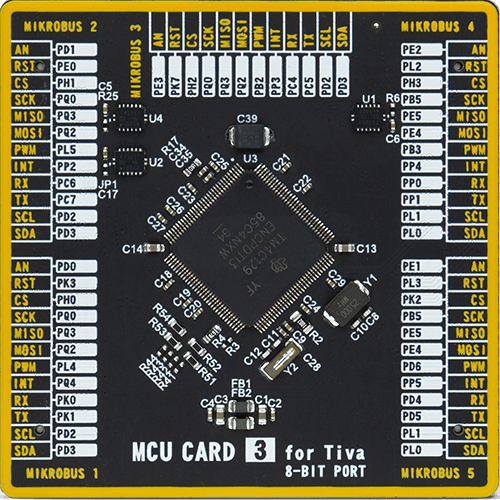
Type
8th Generation
Architecture
ARM Cortex-M4
MCU Memory (KB)
1024
Silicon Vendor
Texas Instruments
Pin count
128
RAM (Bytes)
262144
Used MCU Pins
mikroBUS™ mapper
Take a closer look
Click board™ Schematic

Step by step
Project assembly
Software Support
Library Description
This library contains API for EEPROM 9 Click driver.
Key functions:
eeprom9_set_write_enable- EEPROM 9 enable write functioneeprom9_read_memory- EEPROM 9 memory reading functioneeprom9_block_erase- EEPROM 9 memory block erase function.
Open Source
Code example
The complete application code and a ready-to-use project are available through the NECTO Studio Package Manager for direct installation in the NECTO Studio. The application code can also be found on the MIKROE GitHub account.
/*!
* @file main.c
* @brief EEPROM 9 Click example
*
* # Description
* This is an example that demonstrates the use of the EEPROM 9 Click board.
*
* The demo application is composed of two sections :
*
* ## Application Init
* Initializes the driver and USB UART logging, disables hold and write protection.
*
* ## Application Task
* Writes a desired number of data bytes to the EEPROM 9 memory into a specified address,
* and verifies that it is written correctly by reading from the same memory location.
*
* @author Stefan Ilic
*
*/
#include "board.h"
#include "log.h"
#include "eeprom9.h"
static eeprom9_t eeprom9;
static log_t logger;
static char demo_data[ 9 ] = { 'M', 'i', 'k', 'r', 'o', 'E', 13 ,10 , 0 };
#define MEMORY_ADDRESS 0x0300
void application_init ( void )
{
log_cfg_t log_cfg; /**< Logger config object. */
eeprom9_cfg_t eeprom9_cfg; /**< Click config object. */
id_data_t id_data;
/**
* Logger initialization.
* Default baud rate: 115200
* Default log level: LOG_LEVEL_DEBUG
* @note If USB_UART_RX and USB_UART_TX
* are defined as HAL_PIN_NC, you will
* need to define them manually for log to work.
* See @b LOG_MAP_USB_UART macro definition for detailed explanation.
*/
LOG_MAP_USB_UART( log_cfg );
log_init( &logger, &log_cfg );
log_info( &logger, " Application Init " );
// Click initialization.
eeprom9_cfg_setup( &eeprom9_cfg );
EEPROM9_MAP_MIKROBUS( eeprom9_cfg, MIKROBUS_1 );
if ( SPI_MASTER_ERROR == eeprom9_init( &eeprom9, &eeprom9_cfg ) )
{
log_error( &logger, " Communication init." );
for ( ; ; );
}
eeprom9_read_identification( &eeprom9, &id_data );
if ( EEPROM9_ST_MANUFACTURER_CODE != id_data.manufact_code )
{
log_error( &logger, " Communication error." );
for ( ; ; );
}
log_printf( &logger, " Manufacturer code: 0x%.2X \r\n", ( uint16_t ) id_data.manufact_code );
log_printf( &logger, " Disabling Hold \r\n" );
eeprom9_set_hold( &eeprom9, EEPROM9_HOLD_DISABLE );
Delay_ms ( 100 );
log_printf( &logger, " Disabling Write Protection \r\n" );
eeprom9_set_write_protection( &eeprom9, EEPROM9_WRITE_PROTECT_DISABLE );
Delay_ms ( 100 );
log_info( &logger, " Application Task " );
log_printf( &logger, " - - - - - - - - - - - \r\n" );
}
void application_task ( void )
{
char rx_data[ 9 ] = { 0 };
eeprom9_set_write_enable( &eeprom9, EEPROM9_WRITE_ENABLE );
Delay_ms ( 10 );
eeprom9_write_memory( &eeprom9, MEMORY_ADDRESS, demo_data, 9 );
log_printf( &logger, " Write data: %s", demo_data );
Delay_ms ( 100 );
eeprom9_read_memory( &eeprom9, MEMORY_ADDRESS, rx_data, 9 );
log_printf( &logger, " Read data: %s", rx_data );
log_printf( &logger, " - - - - - - - - - - - \r\n" );
Delay_ms ( 1000 );
}
int main ( void )
{
/* Do not remove this line or clock might not be set correctly. */
#ifdef PREINIT_SUPPORTED
preinit();
#endif
application_init( );
for ( ; ; )
{
application_task( );
}
return 0;
}
// ------------------------------------------------------------------------ END
